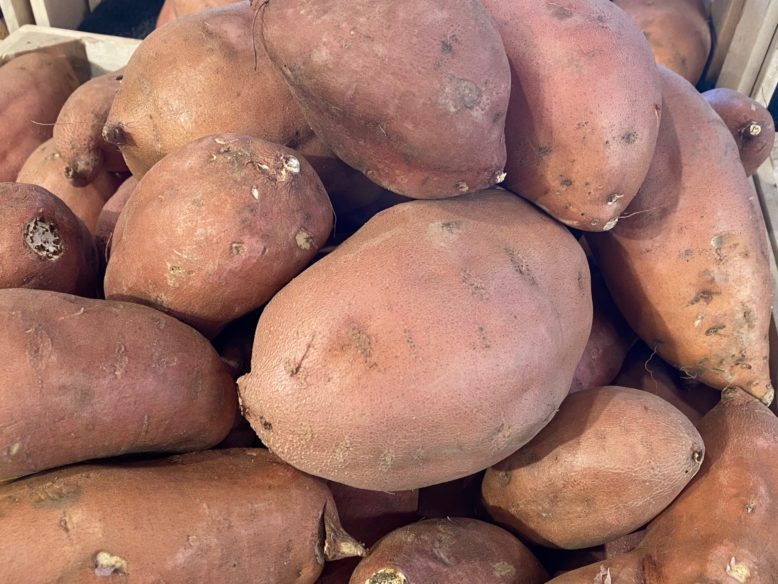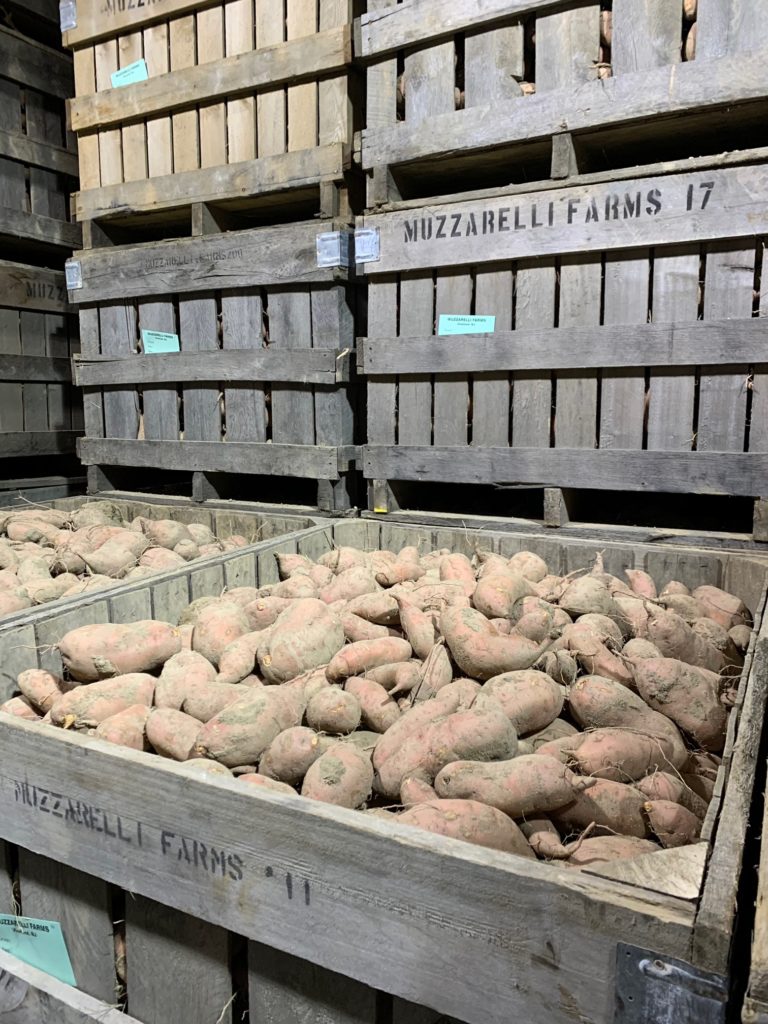
As late fall rolls around each year, nothing gets me more in the mood for Thanksgiving than the thought of a delicious and quintessential side dish made with yams. But this tradition also invariably triggers an annual discussion over what a yam actually is and whether the terms “yam” and “sweet potato” are interchangeable. I hope that I can help settle this holiday debate once and for all!
The bottom line is that 90 percent of what you see marked “yam” in the stores is actually a variety of sweet potato. The true yam is a tuber that grows primarily in the tropical zones of Africa and can get as large as 100 pounds. The potato with the sweet orange-red flesh that grows in the southern part of the U.S. was dubbed a “yam” hundreds of years ago and the name stuck.
De-Bunking the Debate
Most grocery stores offer two similar-looking tubers—some labeled as yams and some as sweet potatoes. The fact is, all those times you thought you were eating yams, you were likely eating a sweet potato and you’ve probably never actually had a true yam. Here’s the scoop on these two tubers, with tips for getting the one you want at the grocery store.
While much of the confusion stems from these names being used interchangeably in U.S. markets and in recipes, sweet potatoes and yams are actually two very different vegetables. Most importantly, sweet potatoes aren’t a type of yam, and yams aren’t a type of sweet potato. They’re both tuberous root vegetables that come from a flowering plant, but they’re not related and actually don’t even have a lot in common.

Harvested sweet potatoes being stored and cured at Muzzarelli Farms in Vineland. Photo courtesy of Muzzarelli Farms
Yams are native to Africa and Asia, with the majority of the crop coming from Africa. They’re related to lilies, and can be as small as a regular potato or jumbo in size—in fact, some grow to five feet long! Yams have a cylindrical shape with blackish or brown, bark-like skin and white, purple, or reddish flesh. Compared to sweet potatoes, yams are also starchier and drier. They’re carried in more grocery stores these days, but your best chance of finding them is to look in international and specialty markets.
American sweet potatoes are members of the morning glory family. The rich orange-fleshed variety is harvested beginning in August and the bulk of the crop is then held in a heated, humidity-controlled environment for about a week, a process which “cures” the potato and converts much of its starch to sugar. A cured sweet potato is actually much sweeter than an uncured one and is what usually shows up on the Thanksgiving table. There are many varieties of sweet potatoes—their skin color can be white, yellow, red, purple or brown, while their flesh can be white, yellow, orange or even orange-red. These vegetables have an elongated shape with tapered ends.
There are two other varieties of sweet potato that are much less frequently seen these days than the one that masquerades as a yam. The red sweet potato has a yellow flesh that’s a bit sweeter than the white sweet potato, which has a white, more fibrous flesh. The red sweet potato has a dark, reddish skin and is in season about the same time as the yam, starting in September. It keeps better than the white sweet potato, which has a very short season—usually the last couple of weeks in August.
Growing Sweet Potatoes

Charlie Muzzarelli, owner of fourth-generation Muzzarelli Farms in Vineland, displays sweet potatoes from their annual crop. Photo courtesy of Muzzarelli Farms
At Muzzarelli Farms, a 350-acre, fourth-generation family operation in Vineland founded in 1937, three different varieties of sweet potato—the Covington, Bonita and Japanese—are grown across 150 acres beginning every spring.
“We plant them as sprouts in May/June, and then dig up the potatoes 90 to 110 days later using a machine,” explained owner Charlie Muzzarelli. “We begin harvesting the earliest sweet potatoes [the white Bonita variety] beginning in August followed by the others through October, then cure them and sell them to a range of brokers, food processing firms, and a fresh market in Philadelphia as well as to customers in our own store.”
As one of a small number of major growers of this crop remaining in the state, Muzzarelli said that sweet potatoes are susceptible to damage from deer, insects, and the weather and that this year’s crop was “fair” due to the excessive rain in our region. “Sweet potatoes are a ‘blind man’s business’ because you can’t see what they look like underground until you dig them up,” he said. “But they’re good for you, and we have a big demand for sweet potatoes and sell a lot of them in our farm market.”
Season, Selection, and Preparation

Produce Pete shares information on yams with anchorwoman Jen Maxfield during a recent segment for NBC Weekend Today in New York. Photo courtesy of Pete Napolitano/NBC
Avoid buying sweet potatoes in June and July, as by then most of them have been stored for nearly a year. Uncured sweet potatoes start showing up on the market in late August; cured sweet potatoes arrive around the end of October. By Thanksgiving almost all that are on the market have been cured. The less common white and red sweet potatoes have a much shorter season at the end of the summer.
Look for bright-colored skin that’s free of bruises or soft spots. Also inspect the ends of the potatoes, which should be firm. Most sweet potatoes have some fibrous roots on them, but these aren’t a problem. An excellent source of fiber and other nutrients, yams and sweet potatoes are a great source of potassium and manganese, which are important for supporting metabolism as well as bone and heart health.
Yams and sweet potatoes are delicious mashed, baked, or boiled and make iconic and rich potato salad, fries, and fillings for pies and other baked goods. To my mind, nothing says fall or the holidays like a sweet potato or yam pie, and my wife Bette’s recipe is always a big hit at our holiday table every November. Hope you enjoy it as well and wishing you and your family a happy and healthy Thanksgiving!
Bette’s Best Sweet Potato Pie
Makes two small pies yielding 6 to 8 servings each
Ingredients:
8 medium-sized sweet potatoes, peeled and cut into chunks
½ cup sugar
6 eggs
½ cup (1 stick) unsalted butter, melted
1 8-ounce can sweetened condensed milk
¼ cup flour
1 teaspoon vanilla extract
1 teaspoon lemon extract
2 unbaked 9-inch pie shells
Directions:
Preheat the oven to 450 degrees. In a large saucepan of water, boil the yams/sweet potatoes until fork-tender, then drain and place in a large bowl. Using a fork or ricer, mash the potatoes. Add the sugar, eggs, butter, milk, and flour and blend well. Add the vanilla and lemon extracts and beat with a wooden spoon until light and fluffy. Fill the pie shells with the potato mixture and bake for 15 to 20 minutes or until the tops are light brown. Serve warm or cold, with whipped cream or ice cream if desired, and enjoy.
About “Produce Pete” Napolitano
With over 65 years of experience in the produce industry, New Jersey’s own “Produce Pete” Napolitano is a renowned fruit and vegetable expert, author, and television personality who’s appeared on a highly-popular segment on NBC’s Weekend Today in New York broadcast every Saturday mornings for over 27 years. For more information, visit Pete’s website.
About Susan Bloom
A contributor to New Jersey Monthly and a variety of other well-known local and national publications, Susan Bloom is an award-winning New Jersey-based freelance writer who covers topics ranging from health and lifestyle to business, food and more. She’s collaborated with Produce Pete on a broad range of articles for nearly a decade.
